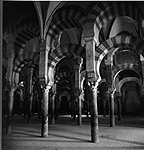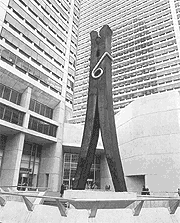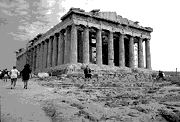| back to: Chapter 2 
Spearbearer
Polykleitos of Argos
marble sculpture
450-440 B.C. (Classical Greek)

Great Mosque at Cordoba
Cordoba, Spain
architecture
786-987 (Islamic)

Clothespin
Claes Oldenburg
Cor-Ten steel with stainless steel base
1976 (Pop Art)

The Parthenon
Acropolis, Athen, Greece
448-432 B. C.
architecture (Classical Greek)
|
Chapter 3: Principles of Design
Unity and Variety
- unity is the use of elements that have similarities in their visual elements
- conceptual unity uses similarity of ideas, rather than visual similarities to hold a design together
Balance
- ACTUAL BALANCE AND PICTORIAL BALANCE
- actual balance is a state of stability in an object that has weight
- pictorial balance refers to the state of visual stability created in a work of art. The Spearbearer by Polykleitos of Argos is a good example of both actual and pictorial balance.
- SYMMETRICAL BALANCE
- symmetrical balance occurs when there is approximate symmetry in a work of art. Leonardo da Vinci's sketchbook drawing of the Vitruvian Man is a good example of symmetrical balance.
- ASYMMETRICAL BALANCE
- asymmetrical balanceoccurs when the visual weight of one side of a work is "heavier" than another
- HORIZONTAL, VERTICAL, AND RADIAL BALANCE
- horizontal balance occurs when the right and left of a work have a great similarities.
- vertical balance occurs when the top and bottom of a work of art have great similarities.
- radial balance occurs when there are similar characteristics that exist equidistant from a center point.
- IMBALANCE is used by an artist to make a viewer uneasy with the image
Emphasis and Focal Point
- emphasis is the visual amplification of areas in a work to draw more of a viewer's attention
- focal point is one area that has been emphasized to a greater extent than others in a work. Leonardo da Vinci's Last Supper uses linear perspective as a tool for creating a focal point in the center of the work.
Rhythm
- rhythm is the presence of orderly progressions in a work
- regular repetition is the reuse of the same or similar elements to create a visual rhythm. Regualr repetition is evident in the Great Mosque at Cordoba in Spain.
Scale
- scale is the relative size of an element compared to tohers like it.
- HIERARCHICAL SCALING is the use of scale to show relative importance. Most Egyptian artwork relied heavily on this attribute of scale. An excellent example of this occurs in the Palette of Narmer. If you look at the work, the most important figures in the political and social order of ancient Egypt are shown larger than the ones of lesser social/politcal importance. Narmer is shown vanquishing his enemies who are shown as smaller in relative size.
- DISTORTION OF SCALE is a process where the artist uses an unfamiliar scale on a familar object or image. Claes Oldenburg's Clothespin is a great example of this. Oldenburg makes an everyday object seem important and even heroic by using large scale.
Proportion
- proportion is the comparative relationship between things
- CANON OF PROPORTIONS: "KEEPING THINGS IN PROPORTION" is a set of rules that propose ideal proportion in common objects. The ancient Greek sculpture the Spearbearer uses such a canon of proportions.
- THE GOLDEN MEAN
- the golden mean or golden rectangle is a set of ratios that are dependent on one another. Using the Golden Mean allows an artist to set up logical proportional relationships in a work of art or architecture. The Parthenon uses this proportional model. The Greeks found that the ratio of 1:1.618 occurred in nature and it reflected their philosophical belief that Man, a natural form, was also an ideal form.
- root five rectangle is another ideal proportion that is derived from the ratio of 1:2.236 or the square root of five
- THE SPIRAL shows the attributes of the Golden Mean as it occurs in nature. The nautilus shell exhibits this ratio in its spiral shape and proportions.
Chapter 4
| |
|
